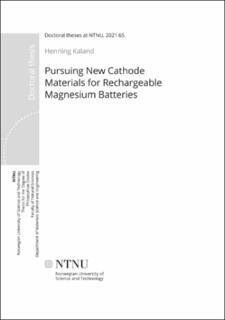| dc.contributor.advisor | Wiik, Kjell | |
| dc.contributor.advisor | Schnell, Sondre | |
| dc.contributor.advisor | Grande, Tor | |
| dc.contributor.advisor | Wagner, Nils Peter | |
| dc.contributor.author | Kaland, Henning | |
| dc.date.accessioned | 2021-03-09T08:35:26Z | |
| dc.date.available | 2021-03-09T08:35:26Z | |
| dc.date.issued | 2021 | |
| dc.identifier.isbn | 978-82-326-5359-1 | |
| dc.identifier.issn | 2703-8084 | |
| dc.identifier.uri | https://hdl.handle.net/11250/2732281 | |
| dc.description.abstract | High-performance and safe batteries based on cheap and sustainable materials are highly desirable to accelerate the transition to a renewable energy-based society. The ongoing electrification of the transport sector has largely been enabled by a drastic cost decline in battery energy, and further cost reductions may be enabled by moving beyond the conventional Li-ion battery redox chemistry. Rechargeable magnesium batteries (RMBs) represent one such technology, with truly attractive theoretical properties. Yet, the realization of RMBs have been hampered by the challenging tasks of developing suitable electrolytes and cathode materials. In this work, several cathode materials have been synthesized and investigated as potential candidates for RMBs.
The first part of the work assessed the feasibility of using MXenes as an RMB cathode material. MXenes, a relatively new large group of 2D materials, have been theoretically predicted to be promising electrode materials for RMBs, with marginal experimental efforts reported. Two of the most well-known MXenes, Ti3C2Tx and V2CTx were successfully synthesized with high phase purity and a controlled particle size. However, negligible Mg2+ intercalation was obtained (capacities generally < 5 mAh/g), regardless of an elevated testing temperature of 60 °C and different electrolytes. The absence of Mg2+ intercalation in MXenes were examined by DFT calculations, revealing challenges with high Mg2+ migration barriers, non-spontaneous intercalation and a propensity for unwanted side reactions. Guidelines for further studies were also provided. In particular, oxygen-terminated multi-layered V2CO2 may be a viable cathode candidate, but will be non-trivial to practically realize.
In the second part, cathodes based on dipenthamethylene thiuram tetrasulfide (PMTT) were investigated and reported with one of the highest capacities for an organosulfur compound for RMBs (295 mAh/g). The high capacity was likely enabled by a solid-liquid conversion mechanism, greatly benefiting from bypassing solid-state Mg2+ diffusion. On the other hand, such a mechanism also caused serious challenges regarding cycle life due to transport and subsequent reduction of soluble cathode species on the Mg anode, analogous to the polysulfide shuttling seen for regular sulfur cathodes. Still, an improved cycling stability was reported compared to a conventional S8 cathode. Possible reasons for the improved performance and the detailed reaction mechanism were discussed. Two different active material preparations and a strong effect of cycling conditions on the electrochemical performance were also reported.
The work from part one and two culminated in the third and last part, where MXene-based composite cathodes with PMTT or S8 as active material were evaluated. Several current collector- and binder-free cathode architectures were fabricated through a facile vacuum-filtration technique. A synergistic effect of MXenes and carbon nanotubes were confirmed, where the carbon nanotubes offered a high surface area for faster reaction kinetics and could prevent MXene restacking, and MXene’s polar surface chemistry was attributed to mitigate polysulfide shuttling and improve capacity retention. A MXene interlayer between the cathode and the separator was found to effectively reduce self-discharge and thereby increase capacity utilization and average voltage, ultimately enabling a capacity of 530 mAh/g at a voltage of ~1.4 V with a capacity retention of 83% after 25 cycles.
All in all, this study aimed to direct further efforts on RMB cathodes in a more viable direction, by 1) narrowing the feasible MXene cathode candidates and emphasize the MXene-specific challenges, 2) report the electrochemical performance of a new organosulfur compound (PMTT) and 3) demonstrate a beneficial role of MXenes as a polysulfide-scavenging conductive additive in the cathode architecture in Mg-S batteries. | en_US |
| dc.language.iso | eng | en_US |
| dc.publisher | NTNU | en_US |
| dc.relation.ispartofseries | Doctoral theses at NTNU;2021:65 | |
| dc.relation.haspart | Paper 1: Kaland, Henning; Hadler-Jacobsen, Jacob; Fagerli, Frode Håskjold; Wagner, Nils Peter; Wang, Zhaohui; Selbach, Sverre Magnus; Vullum-Bruer, Fride; Wiik, Kjell; Schnell, Sondre Kvalvåg. Are MXenes Suitable as Cathode Materials for Rechargeable Mg Batteries?. Sustainable Energy & Fuels 2020 ;Volum 4.(6) s. 2956-2966
https://doi.org/10.1039/D0SE00087F
Reproduced by permission of The Royal Society of Chemistry | en_US |
| dc.relation.haspart | Paper 2: Kaland, Henning; Hadler-Jacobsen, Jacob; Fagerli, Frode Håskjold; Wagner, Nils Peter; Schnell, Sondre Kvalvåg; Wiik, Kjell.
Dipentamethylene thiuram tetrasulfide-based cathodes for rechargeable magnesium batteries. ACS Applied Energy Materials 2020 ;Volum 3. s. 10600-10610
https://dx.doi.org/10.1021/acsaem.0c01655
This is an open access article published under a Creative Commons Attribution (CC-BY) | en_US |
| dc.relation.haspart | Paper 3: Kaland, Henning; Fagerli, Frode Håskjold; Hadler-Jacobsen, Jacob; Zhao-Karger, Zhirong; Fichtner, Maximilian; Wiik, Kjell; Wagner, Nils Peter.
Performance Study of MXene/Carbon Nanotube Composites for Current Collector- and Binder-Free Mg-S Batteries. ChemSusChem 2021
The final published article is available at
https://doi.org/10.1002/cssc.202100173
This is an open access article published under a Creative Commons Attribution (CC-BY) | en_US |
| dc.title | Pursuing New Cathode Materials for Rechargeable Magnesium Batteries | en_US |
| dc.type | Doctoral thesis | en_US |
| dc.subject.nsi | VDP::Technology: 500::Materials science and engineering: 520 | en_US |
